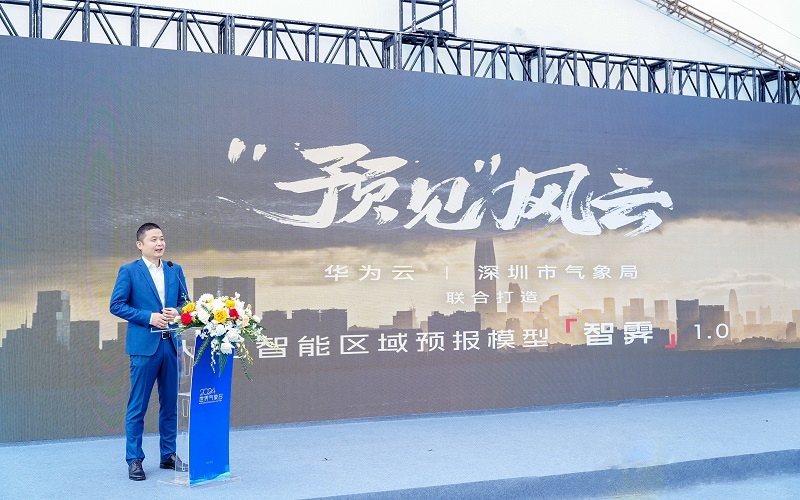[Shenzhen, China, March 25, 2024] Huawei Cloud and the Meteorological Bureau of Shenzhen Municipality jointly announced that their regional AI weather forecasting model has officially been put into use. The regional model is one of the first of its kind. It enables the rapid generation of five-day forecasts for a precise 3 km range. The announcement was made at an event on 23 March in Shenzhen marking World Meteorological Day 2024.
 William Dong, President of Huawei Cloud Marketing Dept, speaks at the World Meteorological Day 2024 event
William Dong, President of Huawei Cloud Marketing Dept, speaks at the World Meteorological Day 2024 event
Named “Zhiji” Regional Model in Chinese, a combination of characters evoking AI technology, Chinese culture, and good weather, the model is based on Huawei Cloud’s Pangu-Weather Model and was pre-trained on high-quality regional datasets. It can generate 5-day forecasts for Shenzhen and its neighboring regions with a spatial resolution of 3 km. The 3km range is much narrower than typical global models which work with a spatial perimeter of 25km. The forecasts cover a wide range of meteorological elements, including temperature, precipitation, and wind speed.
During its trial run last month, Zhiji demonstrated high accuracy in predicting multiple cold-temperature periods. Going forward, the team plans to further enhance the model and refine its ability to provide accurate precipitation forecasts.
For decades, the Meteorological Bureau of Shenzhen Municipality has explored new ways of providing better weather services and enhanced disaster preparedness. “Weather forecasting is crucial to disaster prevention and mitigation,” said Lan Hongping, Deputy Director of the Meteorological Bureau of Shenzhen Municipality. “Shenzhen Meteorological Bureau has been consistently exploring ways to refine weather forecasting and warning services, and we see AI as an important way to do that. Through our joint innovation with Huawei Cloud, we expect to further improve our services so we can better serve the residents of Shenzhen and the city’s future development.”
William Dong, President of Huawei Cloud Marketing Dept, said: “The launch of this regional AI weather model for Shenzhen means that AI can provide new ways to enable accurate, smaller-scale weather forecasts. It also marks an important scientific development following the publishing of a paper on Pangu-Weather Model in renowned scientific journal Nature last July, demonstrating how scientific discoveries can be applied well beyond the laboratory in order to provide tangible benefits.”
Dong added: “Extreme weather is on the rise globally, and AI weather forecasting systems have already shown unique strengths in predicting all kinds of weather conditions. In the future, Huawei Cloud will continue to innovative in AI weather forecasting methods and extend them to benefit more sectors, provide more refined weather services and enhance disaster preparedness.”
According to the World Meteorological Organization, weather, climate and water-related hazards caused close to 12,000 disasters between 1970 and 2021, resulting in the deaths of more than two million people and causing economic damages of $US 4.3 trillion. Early warnings can significantly casualties and prevent economic losses. The more precise weather prediction is, the more effective early warnings are. With its ability to process large volumes of information and detect patterns from them, AI can make weather forecasting more precise and speed up prediction time. Across the globe, meteorological bureaus have incorporated AI models developed by technology companies into their forecasting considerations.
The announcement of a regional model represents another significant development for Pangu-Weather. In July 2023, a paper on Huawei Cloud’s Pangu-Weather Model was published in leading science magazine Nature. In August, Huawei Cloud’s Pangu-Weather Model was made available publicly on the website of the European Center for Medium-Range Weather Forecasts (ECMWF). Pangu-Weather Model was also named a top 10 scientific achievement in China for 2023. In December 2023, Huawei Cloud also announced an initiative to work with the Thai Meteorological Department to develop a Pangu-Weather Model for Thailand.
The monsoon season in Southern China is approaching. Huawei Cloud and the Meteorological Bureau of Shenzhen Municipality plan to work together to further verify and comprehensively evaluate Zhiji during this season, as well as continue to enhance the model and use it to provide useful information for weather forecasters.
PR Archives: Latest, By Company, By Date